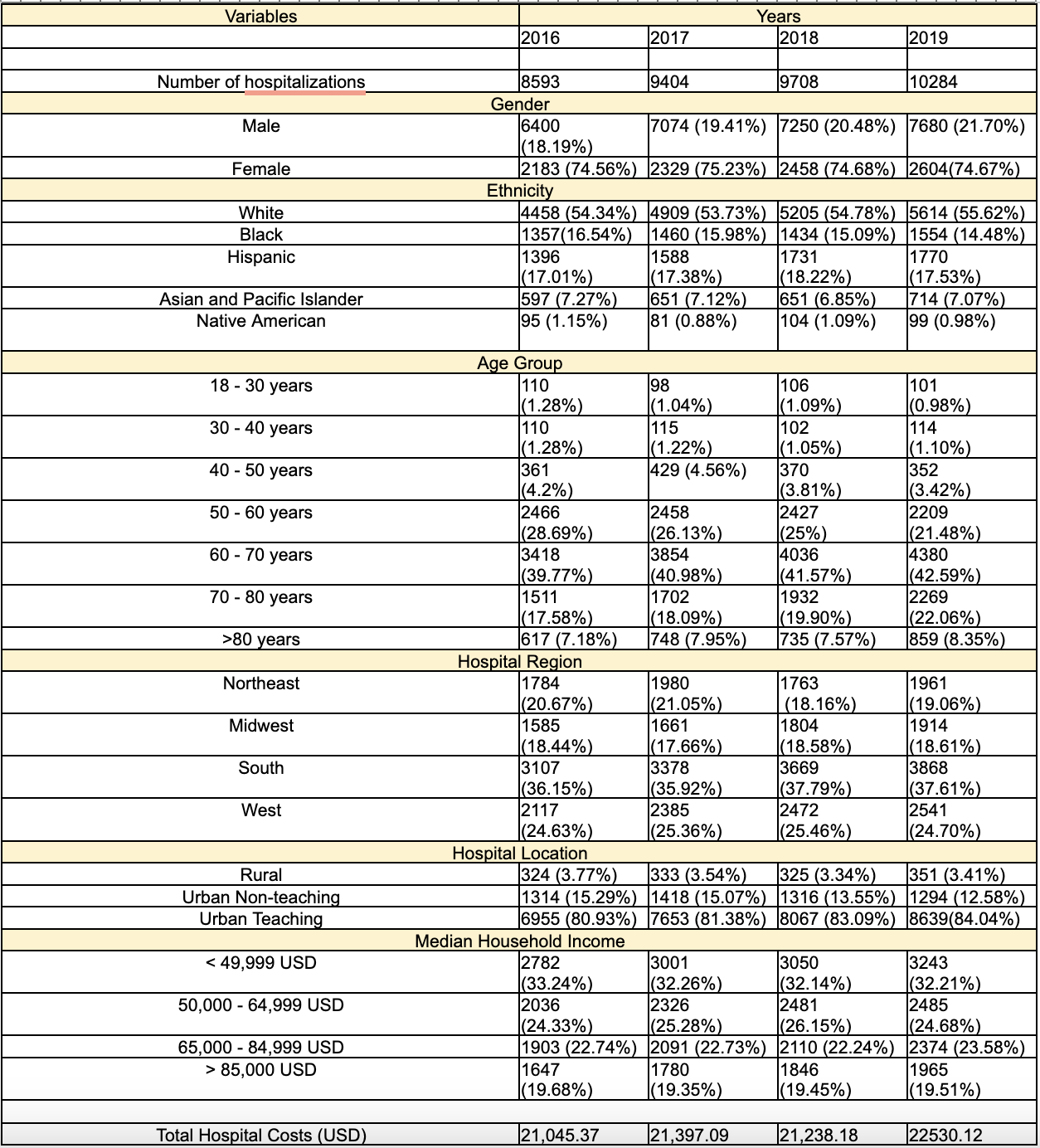Monday Poster Session
Category: Liver
P3737 - Trends and Outcomes in Hepatocellular Carcinoma Admissions in US
Monday, October 27, 2025
10:30 AM - 4:00 PM PDT
Location: Exhibit Hall
.jpg)
Raj H. Patel, MD
St. Mary Medical Center
Langhorne, PA
Presenting Author(s)
Raj H. Patel, MD1, Charmy Parikh, MD2, Sneh Sonaiya, MD, MPH, MBA3, Karan Yagnik, MD4, Pranav Patel, MD5, Sandeep Khurana, MD5
1St. Mary Medical Center, Langhorne, PA; 2Mercy Catholic Medical Center, Darby, PA; 3Kirk Kerkorian School of Medicine at the University of Nevada Las Vegas, Las Vegas, NV; 4Monmouth Medical Center, Long Branch, NJ; 5Geisinger Health System, Danville, PA
Introduction: Hepatocellular carcinoma is the fifth most common cancer worldwide and the second leading cause of cancer death in men. With the increased prevalence of cirrhosis, its incidence is expected to rise. Most common causes of HCC include Hepatitis B & C, Metabolic Dysfunction Associated Liver Disease and Alcoholic Liver Disease.
Methods: We used NIS database from 2016 to 2019 to identify the hospitalizations with a diagnosis of HCC. Trend analysis was performed across various variables like gender, race, age group, hospital region, median household income, costs and mortality. Hospitalization costs were adjusted to inflation for the year 2019. T-test and chi-square tests were also used. All analyses were performed using SAS 9.4.
Results: The number of HCC hospitalizations increased from 8,593 cases in 2016 to 10,284 in 2019 in a statistically significant linear trend. Overall, HCC was more common in males, white ethnicity, in the age group of 60 to 70, in southern US states, and among people with a mean household income of less than 49,999 USD. On further analysis, the trend in mortality was on the uprise with a Z score of 2.445 and a two-sided p-value of 0.0145. Mean hospitalization costs increased from 21,045 USD to 22,530 USD and length of stay increased from 4.89 to 6.51 days in our study. Results are represented in the table.
Discussion: There has been a significant increase in mortality, hospitalization costs and length of stay in patients with HCC. At-risk populations include white ethnicity, male gender, 60 to 70 years old, southern US states and a median household income of less than 49,999 USD. This shows the need for prompt recognition of vulnerable people and implementation of efficient screening programs to reduce HCC burden.

Figure: Table 1. Trends in HCC admissions
Disclosures:
Raj Patel indicated no relevant financial relationships.
Charmy Parikh indicated no relevant financial relationships.
Sneh Sonaiya indicated no relevant financial relationships.
Karan Yagnik indicated no relevant financial relationships.
Pranav Patel indicated no relevant financial relationships.
Sandeep Khurana indicated no relevant financial relationships.
Raj H. Patel, MD1, Charmy Parikh, MD2, Sneh Sonaiya, MD, MPH, MBA3, Karan Yagnik, MD4, Pranav Patel, MD5, Sandeep Khurana, MD5. P3737 - Trends and Outcomes in Hepatocellular Carcinoma Admissions in US, ACG 2025 Annual Scientific Meeting Abstracts. Phoenix, AZ: American College of Gastroenterology.
1St. Mary Medical Center, Langhorne, PA; 2Mercy Catholic Medical Center, Darby, PA; 3Kirk Kerkorian School of Medicine at the University of Nevada Las Vegas, Las Vegas, NV; 4Monmouth Medical Center, Long Branch, NJ; 5Geisinger Health System, Danville, PA
Introduction: Hepatocellular carcinoma is the fifth most common cancer worldwide and the second leading cause of cancer death in men. With the increased prevalence of cirrhosis, its incidence is expected to rise. Most common causes of HCC include Hepatitis B & C, Metabolic Dysfunction Associated Liver Disease and Alcoholic Liver Disease.
Methods: We used NIS database from 2016 to 2019 to identify the hospitalizations with a diagnosis of HCC. Trend analysis was performed across various variables like gender, race, age group, hospital region, median household income, costs and mortality. Hospitalization costs were adjusted to inflation for the year 2019. T-test and chi-square tests were also used. All analyses were performed using SAS 9.4.
Results: The number of HCC hospitalizations increased from 8,593 cases in 2016 to 10,284 in 2019 in a statistically significant linear trend. Overall, HCC was more common in males, white ethnicity, in the age group of 60 to 70, in southern US states, and among people with a mean household income of less than 49,999 USD. On further analysis, the trend in mortality was on the uprise with a Z score of 2.445 and a two-sided p-value of 0.0145. Mean hospitalization costs increased from 21,045 USD to 22,530 USD and length of stay increased from 4.89 to 6.51 days in our study. Results are represented in the table.
Discussion: There has been a significant increase in mortality, hospitalization costs and length of stay in patients with HCC. At-risk populations include white ethnicity, male gender, 60 to 70 years old, southern US states and a median household income of less than 49,999 USD. This shows the need for prompt recognition of vulnerable people and implementation of efficient screening programs to reduce HCC burden.

Figure: Table 1. Trends in HCC admissions
Disclosures:
Raj Patel indicated no relevant financial relationships.
Charmy Parikh indicated no relevant financial relationships.
Sneh Sonaiya indicated no relevant financial relationships.
Karan Yagnik indicated no relevant financial relationships.
Pranav Patel indicated no relevant financial relationships.
Sandeep Khurana indicated no relevant financial relationships.
Raj H. Patel, MD1, Charmy Parikh, MD2, Sneh Sonaiya, MD, MPH, MBA3, Karan Yagnik, MD4, Pranav Patel, MD5, Sandeep Khurana, MD5. P3737 - Trends and Outcomes in Hepatocellular Carcinoma Admissions in US, ACG 2025 Annual Scientific Meeting Abstracts. Phoenix, AZ: American College of Gastroenterology.
